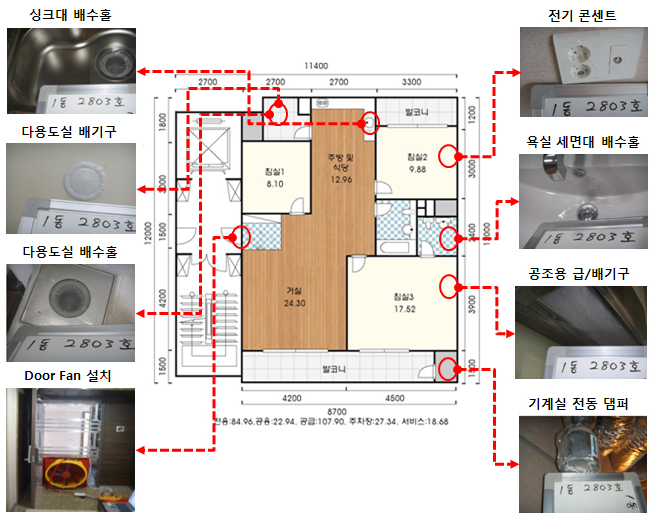미래가치를 만드는 기업 3S KOREA
To create future value company 3S KOREA
Blower Door Test
●Production explanation
The fan
pressure test method by the pressure difference method using the blower door. The
amount of sedimentation was measured by increasing or decreasing the pressure
in the room at intervals of 5 Pa to 10 Pa up to 10 to 50 Pa and it is common
practice to estimate the amount of steady-state 4Pa sedimentation based on the
results. Also, the indoor and outdoor conditions should be tested under
conditions of 0 ~ 2m / s in the meteorological condition and 5 ~ 35 ℃ in the
outside temperature according to the ASTM standard, with the condition of the ventilator
of kitchen and toilet sealed while measuring
●Configuration
Blower door
& fan, pressure measuring device, temperature measuring device, air flow
measuring device, wind speed measuring device (optional), etc.
●Correlation with Leed
Blower door
test uses a high-power fan and air pressure sensor to measure airtight
performance of building and identify problems so that it can be repaired to
improve energy management of building, reduce indoor air pollution and control
indoor environmental levels
The fan uses an
enclosed frame to meet customer’s requirements and is mounted on the outside
door. The fan blows air out of the building and the pressure sensor measures
the room air pressure
The generated pressure difference creates air by penetrating all holes and building envelopes (flowing into inside from the outside). It is usually easy to see and feel where holes and penetrations are. These problems are more likely to be detected than chemical fumes or infrared cameras or simple feelings by hand.
The generated pressure difference creates air by penetrating all holes and building envelopes (flowing into inside from the outside). It is usually easy to see and feel where holes and penetrations are. These problems are more likely to be detected than chemical fumes or infrared cameras or simple feelings by hand.
Ideally, there
will be, "air conditioned space", some outdoor air flow to prevent
mold, backwash, stagnant air, and other stagnant conditions caused by very
little airflow wherever in the office or residence.
Test results can be used for the purpose of evaluating indoor air quality and the need for mechanical ventilation, as well as mathematical models for estimating the annual average and designing permeability. It is also helpful to determine the proper size of the heating and cooling system
Test results can be used for the purpose of evaluating indoor air quality and the need for mechanical ventilation, as well as mathematical models for estimating the annual average and designing permeability. It is also helpful to determine the proper size of the heating and cooling system
In testing
apartment houses, assuming one thing, and with respect to future LEED
certification for homes, LEED established a standard for apartment house
airtight performance of 8.1 cm² of leakage space per 9.3 m² of enclosed space.
This is equivalent to a smoking area of 0.868 cm² / m² in a building, which is
intended for unit-household tabacco smoke control (Environment Tabacco Smoke
(ETS) Control).
●Blower Door Test performance references
| Gale International Korea – - Incheon Songdo 125Block (380 generations) |
| POSCO E&C – Incheon Songdo D1~D5 (65 generations) |
|
GS
E&C - Incheon Songdo Zai Harbor View (12 generation) |
옵 션
옵션 Part
별도 구매 가능



